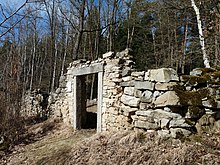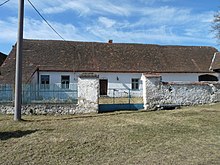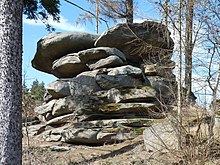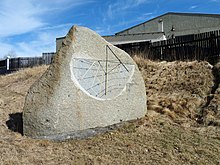Slatina u Horažďovic
| Slatina | ||||
|---|---|---|---|---|
|
||||
| Basic data | ||||
| State : |
|
|||
| Region : | Plzeňský kraj | |||
| District : | Klatovy | |||
| Area : | 564,488 ha | |||
| Geographic location : | 49 ° 23 ' N , 13 ° 45' E | |||
| Height: | 430 m nm | |||
| Residents : | 107 (Jan. 1, 2019) | |||
| Postal code : | 341 01 | |||
| License plate : | P | |||
| traffic | ||||
| Street: | Kasejovice - Horažďovice | |||
| structure | ||||
| Status: | local community | |||
| Districts: | 1 | |||
| administration | ||||
| Mayor : | Václav Vachuška (as of 2014) | |||
| Address: | Slatina 62 341 01 Horažďovice |
|||
| Municipality number: | 578436 | |||
| Website : | www.obec-slatina.eu | |||
Slatina is a municipality in the Czech Republic . It is located eight kilometers north of Horažďovice and belongs to the Okres Klatovy .
geography
Slatina is located in the Blatenská pahorkatina hill country. The village is located on the Slatina stream of the same name, which flows into the Svéradický potok southwest of Slatina. The Babáček (551 m) rises to the north, the Na Soudné (534 m) to the east, the Hřeben (552 m) south-east and the Radílec (491 m) to the west. To the northeast is the Vůsí pond and the Strašín pond to the south.
Neighboring towns are Nezdřev , Bezděkov, Hradiště and Zahorčičky in the north Pole, Kadov and Vrbno in the Northeast, Lnářský Málkov, Lažánky and Záboří the east, Čečelovice , Slivonice and Komušín in the southwest, Svéradice in the south, Velký Bor , U Pazderny and Barák in southwest , Holkovice, Plácek and Dobrotice in the west and Újezd u Chanovic and Chanovice in the northwest.
history
Slatina was founded around 1150 and belonged to the Slavic settlement area around the fortifications of Hradiště and Prácheň . The village was first mentioned in 1227 as the property of the St. George Monastery at Prague Castle, which laid out a courtyard in Slatina around 1220 and built the first church in the area. In 1284 the Prague bishop Tobias von Bechin sold the Slatina and Pole farms to the Burgrave Bohuslav von Zvíkov . This sold Slatina in 1303 to Peter von Nebřehovice. Due to the colonization of the monastery and the subsequent owners, Slatina had grown to 30 houses. In the summer of 1421 Jan Žižka's army marched through the area on the way to the second siege of the Rabí Castle and the wooden church of St. Wenceslaus down. Střízek von Nebřehovice had the stone chapel of St. Build Wenceslas. In 1426 he sold the goods Nebřehovice and Slatina to Oldřich Kočka on Droužetice , who sold Slatina in 1436 to Jan von Nebřehovice. The Nebřehovský von Nebřehovice sold the Slatina estate in 1517 to Heinrich Woselsky von Langendorf auf Woselecz , who was followed in 1543 by his son Peter. The village of Slatina had been divided since then at the latest; In 1543 Bušek Záborský von Brloh was registered in the land table as the owner of the goods Kadov , Záboří and a share of Slatina.
After the death of Peter Woselsky von Langendorf in 1578, his widow Nabka inherited the Woselecz estate with all its accessories. She shared the property with her three daughters in 1583, while Markéta Kokořovec received the goods Woselecz and Slatina from Kokořov. Markéta and her husband Jan Kokořovec von Kokořov had the family property divided between their four sons and three daughters, with the goods Woselecz, Kotouň and Slatina going to Jan Vilém Kokořovec and his wife Eva Kateřina, née Markvart von Hrádek. Presumably they bequeathed their share in Slatina to the town of Horažďovice in favor of the hospital. The other share was inherited by Bušek's son Alexander Záborský von Brloh, who was followed in 1620 by his eldest son, Alexander Václav. He probably had a manor built in Slatina and used the predicate Záborský from Brloh to Slatina. In the berní rula of 1654 nine farmers, four chalupners and six gardeners are reported for Slatina; the Horažďovice share included four farmers, one chalupner and two gardeners, the Záborský share included five farmers, three chalupners and four gardeners. Alexander Václav Záborský sold his share in 1677 to Jan Kavka von Svárov and made the Kozlov fortress his new seat. In 1680 Adam Oppel bought this share. His widow Afra Ursula, née Wiedersperger von Wiedersperg , sold the share in Slatina to her son-in-law Wenzel Ferdinand Lew Kunasch von Machowitz in 1688. Kunash had a new manor built in Slatina in 1724. In 1731 he also acquired the Horažďovicer share from Slatina and united both parts. From 1736 his widow managed the property for her underage sons Johann Joseph and Johann Ernst until 1755. On November 8, 1762, the brothers sold the Slatina estate for 21,000 guilders to Johann Franz Christian Graf Swéerts-Sporck , who added it to his rule in Schlüsselburg . As a result of the bad harvest of 1770, there was a great increase in prices and famine in Bohemia. In the summer of 1771 a peasant revolt broke out in the area; the unarmed rebels moved to Schloss Schluesselburg and demanded the degradation of the robot. The military summoned from Horažďovice put down the rebellion with blood, and the judge from Slatina was among the dead. In the 18th and 19th centuries, numerous small granite quarries were built between Kadov, Desfours-Laschan and Slatina. After the death of Joseph Graf Swéerts-Sporck, the Oberstlandmarschall Johann Prokop Graf Hartmann von Klarstein administered the rule Schlüsselburg for his underage children from 1802 and sold it to the former Passau Prince-Bishop Leopold Leonhard von Thun on April 23, 1803 for 1,350,000 Rhenish guilders Hohenstein , who sold them on to Johann Franz Linker von Lützenwick on August 27, 1804 for 1,580,000 guilders and 4,000 guilders key money . Linker separated the Slatina estate from the Schluesselburg estate and on February 20, 1811, left it to the owner of the Chanowitz estate , the Pilsen citizen Franz Becher, for a purchase price of 21,000 guilders and 1,000 guilders key money . After 1811, Slatina Castle was converted into a granary and the chapel of St. Wenzel canceled. In 1838 Franz Gustav Becher inherited the Slatina estate. Until the middle of the 19th century, Slatina was part of the Chanowitz rule.
After the abolition of patrimonial Slatina formed from 1850 a municipality in the judicial district of Horažďowitz. The large pond Na Líští at the southern end of the village was drained in the second half of the 19th century. From 1868 the village belonged to the Strakonitz district . Franz Gustav Freiherr von Becher sold the Slatina farm on August 1, 1871 for 30,000 guilders to Eduard Daubek, who also acquired the Chanowitz estate. This was followed by his son Eduard Ritter von Daubek, who discovered and promoted the painter František Bohumil Doubek. In 1883 the old farm was destroyed in a big fire. Eduard Ritter von Daubek had a new farmyard built in his place according to plans by the Pilsen master builder Josef Kába, while the former castle and the old warehouse were demolished. From Daubek, who had also become the owner of the castle and the Wosek estate , Chanowitz and Slatina sold on August 19, 1889 for 180,000 guilders to the owner of the kaolin mines Horní Bříza , Isidor Schmiedl at Vísky Castle. After his death, his widow Pavlína, née Marešová, managed the large estate from 1900. Ten years later, daughter Anna , who was married to Paul Goldegg zu Lindenburg , inherited the property. From 1938 the Chanowitz and Slatina estates were jointly owned by the siblings Franz, Ferdinand and Georg Goldegg zu Lindenburg and Elisabeth Heintschel von Heinegg, with the former managing the property. In May 1945 Franz Goldegg zu Lindenburg was shot in Chanovice. The Goldegg zu Lindenburg family was expropriated by a Beneš decree in December 1945 and their property was nationalized. The Slatina farm was parceled out in 1947 and assigned to smallholders. From 1949 Slatina belonged to Okres Horažďovice, after its abolition the community was assigned to Okres Klatovy in 1960. On July 1, 1976, it was incorporated into Svéradice, between 1980 and 1991 Slatina belonged to Velký Bor as a district . Since January 1st, 1992 Slatina has again formed its own community. A large quarry was built north of Slatina after 2000 by the Průmyslkome, as. The community is a member of the international partnership project European Slatina.
Jewish community
Wenzel Ferdinand Lew Kunasch von Machowitz, who had acquired a share of Slatina in 1688, permitted the settlement of Jews from 1691. In addition to renting out abandoned chalets, Kunash also left a piece of swampy land to the Jews to build their own houses, whereupon the ghetto was built from a group of terraced houses with a size of only 5 × 6 meters made of stones, adobe bricks and wood. The livelihoods of the Jews were the grain and cattle trade, peddling and usury. In return for payment of a substantial part of the income as protection money, the Kunasch von Machowitz also favored protection Jews. A wooden synagogue was built in the middle of the ghetto for services. At the end of the 17th century a small Jewish school was established. Twelve villages belonged to the catchment area of the Jewish community .
In 1723, Wenzel Ferdinand Kunasch von Machowitz allowed the Jewish community to set up their own cemetery outside the town. Jews from other places were also buried in the cemetery, which initially had an area of 8 × 8 fathoms. Later the cemetery was enlarged.
In 1834 there were 17 Jewish families in Slatina. In 1846 the ghetto consisted of eleven houses in which 19 Jewish families with a total of 110 people lived. In addition, 19 other Jews lived in Christian houses. The Jews thus made up a third of the population of Slatina. From 1850, Jews began to emigrate mainly to the United States , but also to Bosnia-Herzegovina . In 1868, the Jewish community bought a piece of land on the village square to build a new representative synagogue , which also housed the school and an apartment for the rabbi. The Slatina Jewish community experienced a further weakening through the formation of its own Jewish community in Enis-Laschan . Between 1850 and 1894, a total of 250 Slatina residents emigrated to the USA, 134 of them in 1894 alone. The Jewish school stopped teaching in 1893 due to insufficient student numbers. In the same year, Gottlieb Schlessner, the last rabbi, left Slatina. In 1898, Moses Hasterlik donated 2,000 guilders to the Jewish community of Horažďovice for the maintenance of the synagogue for a further ten years. In 1917 the last Jewish family left Slatina. The Jewish community of Horažďovice then sold the synagogue, which was no longer needed, on September 20, 1917 for 10,800 crowns to the dealer and music teacher Karel Volmut, who set up a shop on the school premises and used the prayer hall as a warehouse.
Community structure
No districts are shown for the municipality of Slatina. The one- shift U Kutila belongs to Slatina .
Attractions
- Chapel of St. Wenzel on the village square, built in 1865 instead of a dilapidated previous building. The altarpiece of St. Eduard, like the bell, is a gift from Eduard Ritter von Daubek and was probably painted by František Bohumil Doubek. The statue of Ecce homo was bought by the judge Ladman at the auction of the inventory of the abolished Horažďovice monastery for half a thaler.
- Niche chapel of St. Wenceslas on a wall of the former castle on the way to Čečelovice and Slivonice, it reminds of the former castle chapel
- Late baroque niche chapel of St. Barbara on the Na Hradcích hill near the quarry, it was built at the end of the 18th century. The mural of St. Barbara was created by the Prague painter Josef Fencl.
- New synagogue on the village square, the classicist building was built in 1868 and sold to a merchant in 1917 after the last Jews left. In the second half, the JZD Slatina stored fertilizers in it; after their merger with the JZD Svéradice, the cooperative had no more use for the building and sold it. The buyers had the building restored to its original state. Today it serves as a Jewish cultural center.
- Remnants of the ghetto
- Jewish cemetery, in the Na Hradcích forest north of the village, laid out in 1723. There are 172 tombstones on the 58 × 28 m area. When representatives of the Israeli section of ICOMOS visited the synagogue , they recommended the protection of the synagogue and the cemetery as a unique complex of a rural Jewish settlement.
- Velký čertův náramek ( Great Devil's Bracelet ), rock formations between Slatina and Kadov
- Sundial at the quarry
Individual evidence
- ↑ http://www.uir.cz/obec/578436/Slatina
- ↑ Český statistický úřad - The population of the Czech municipalities as of January 1, 2019 (PDF; 7.4 MiB)









